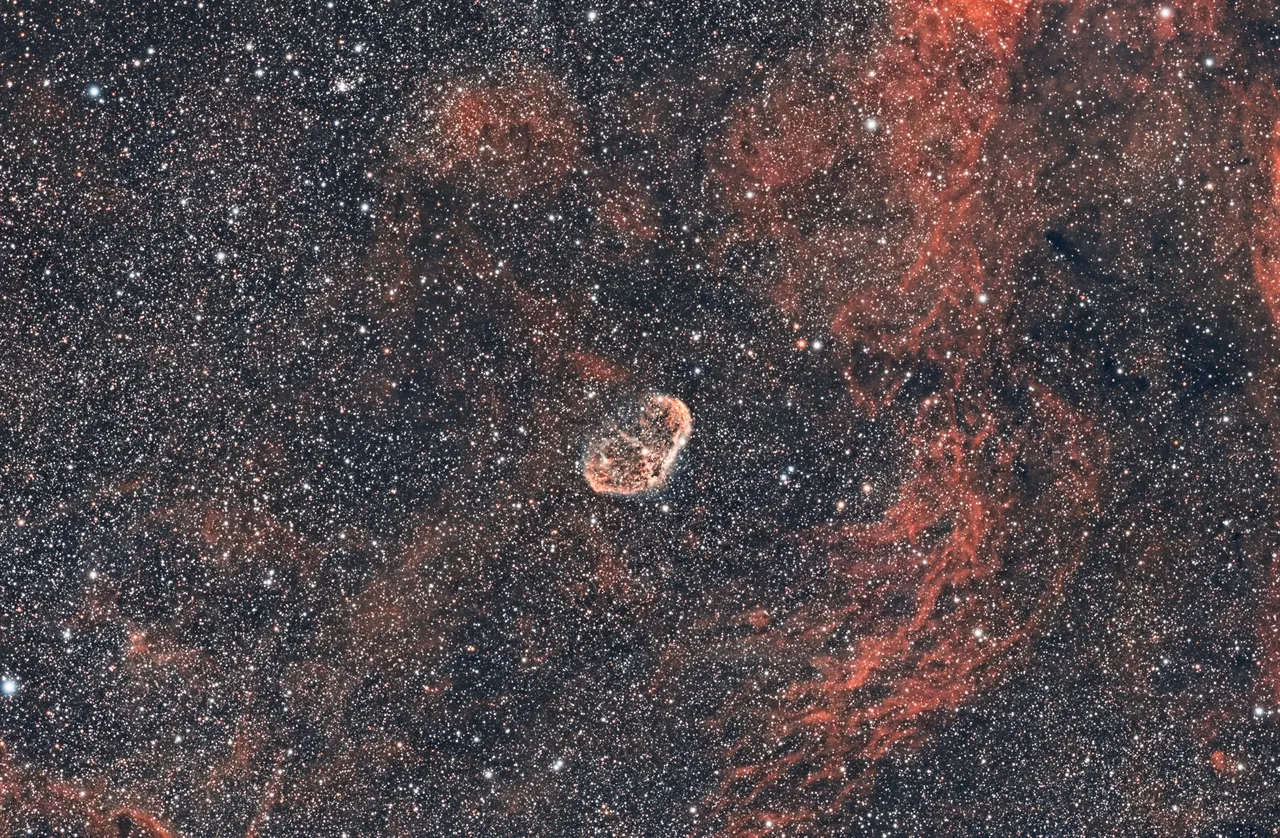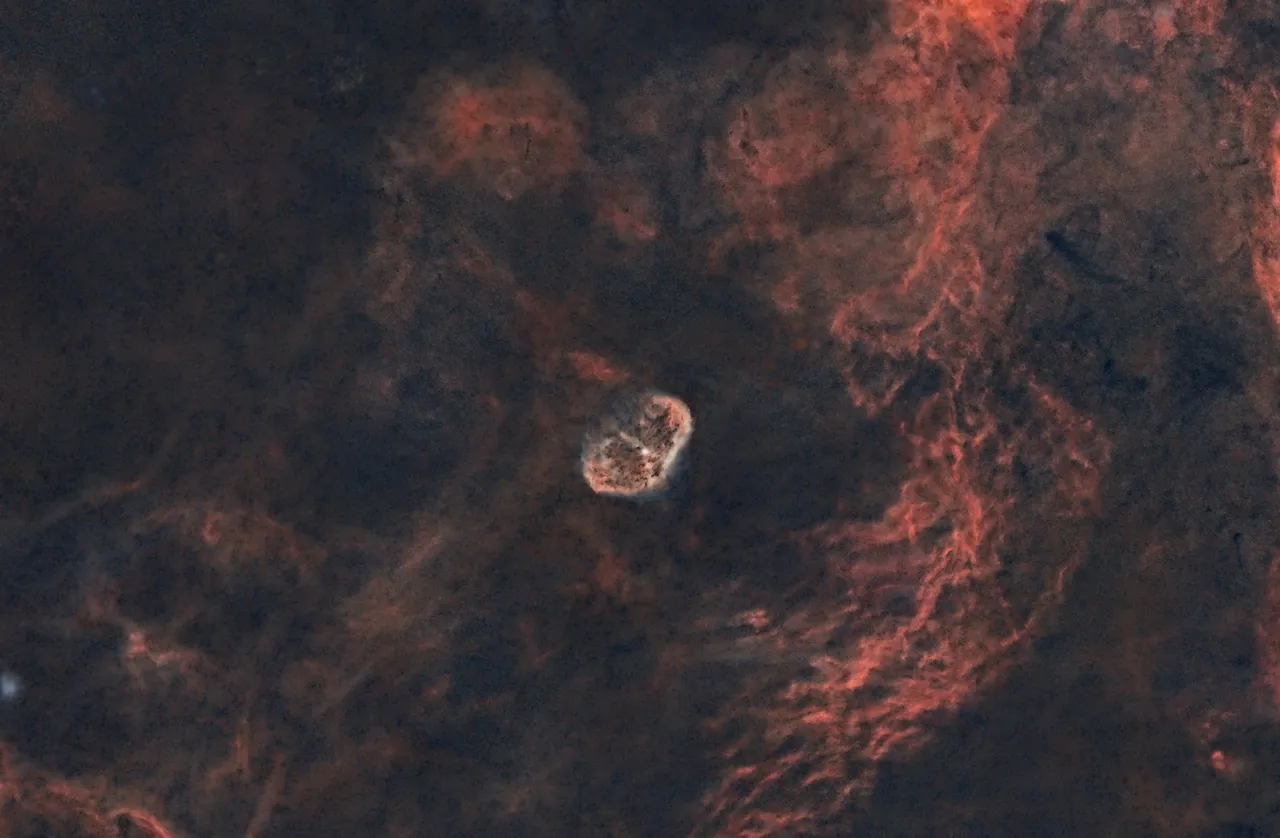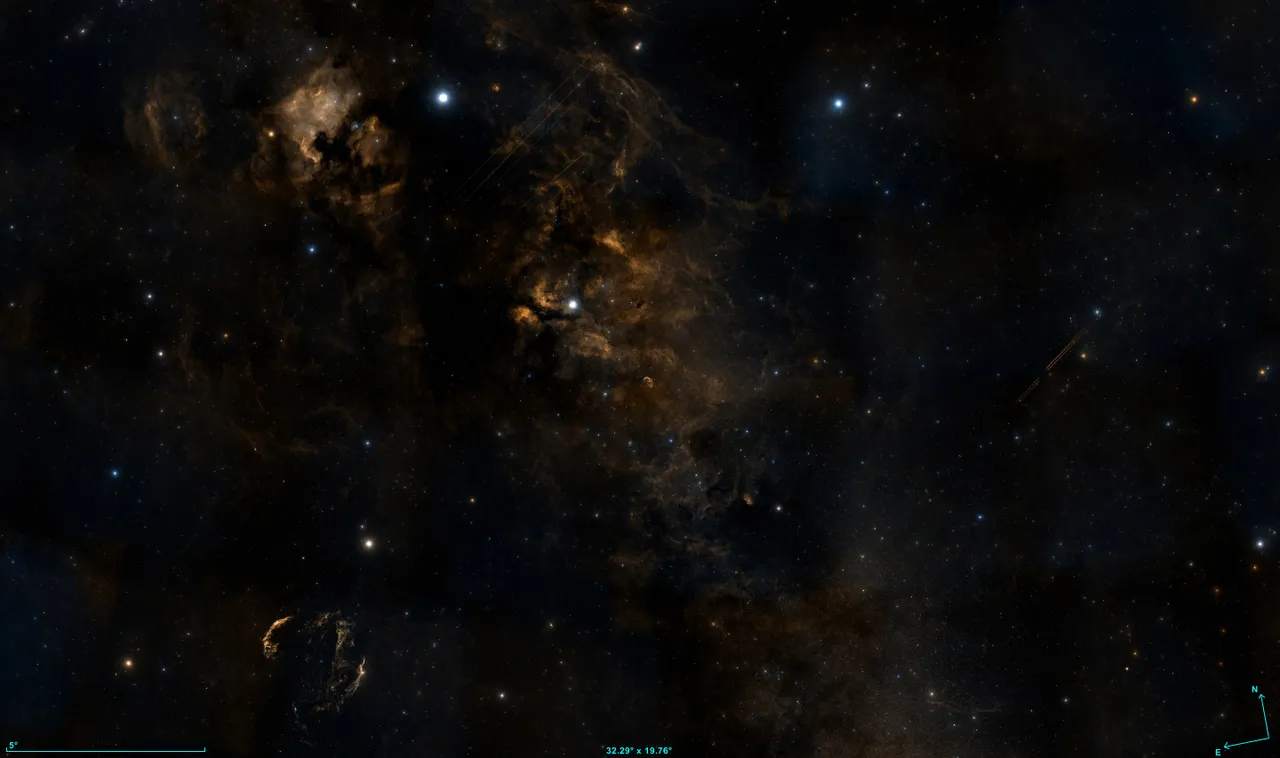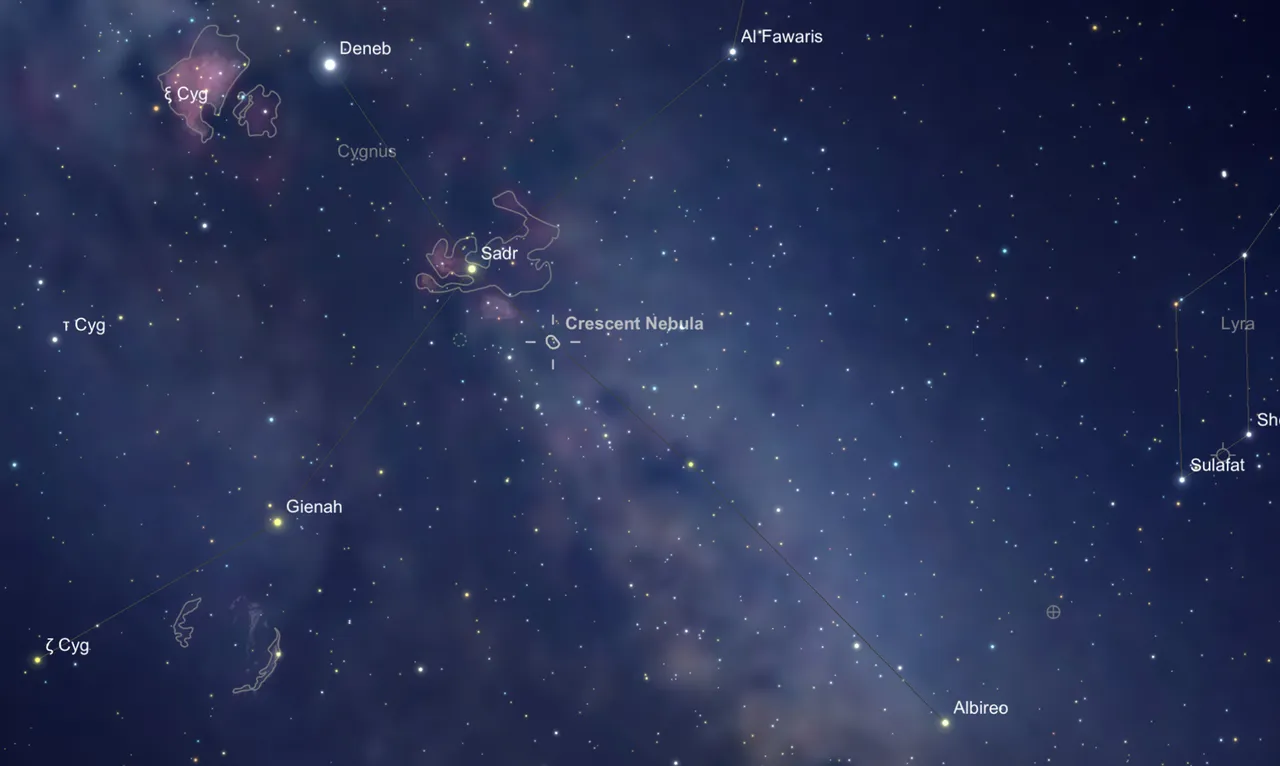The Cresent Nebula (NGC6888) is a bigger (regarding its apparent size) Emission Nebula and is located in the constellation of Cygnus, approximately 4,700 light-years away from us. As already written in my previous posts, the constellation of Cygnus itself is placed in a highly active and dense region of our Milky Way, which contains many interesting objects and countless stars.
In 1792 the Crescent Nebula was discovered by Wilhelm Herschel. Almost a hundred years later, in 1888, it was numbered with 6888 in the then published New General Catalogue of Nebulae and Clusters of Stars (NGC).
In the "center" of the Cresent Nebula is the Wolf-Rayet star WR 136, which is believed to have created this emission nebula by rejecting significant parts of its matter. The gases released by the star, mostly hydrogen (red in the image) and also a bit of oxygen (very faint blue in the image, nearly invisible), are ionized by its radiation and therefore stimulated to illuminate light in their corresponding wavelengths.
The Cresent Nebula captured with a focal length of 420mm.

Click on the image for a larger view ▲
Wolf-Rayet stars are the remaining nuclei of massive stars that have repelled or are still repelling their matter respectively their gases. So far, Wolf-Rayet stars with 10 to 265 times the mass of our sun have been discovered. Their measured and calculated surface temperatures range from 30,000 to 120,000 degrees Kelvin.
The Cresent Nebula lies in the foreground of an enormous cloud complex out of ionized gases and dust. As mostly all other objects in the constellation Cygnus, you can't see this background complex very well due to the very high number of stars. To make this background cloud complex more visible, I removed the stars in the picture.
My attempt to remove the stars so that the background nebula can be recognized better.

Click on the image for a larger view ▲
As mentioned above the cloud complex is huge. Its measured size in Aladin is around 6.5 by 13 degree. For comparison, the full moon will cover an area of about 0.5 degrees in diameter on the night sky.
For visualization, you can find the Cresent Nebula in the center of the Aladin Sky Atlas screenshot. It is the small bubble-like object in front of the gigantic molecular cloud. You can also see the North America Nebula in the upper left and the Eastern Veil Nebula on the lower left side.
The whole background nebula complex. Screenshot of Aladin Sky Atlas.
 Click on the image for a larger view ▲
Click on the image for a larger view ▲
This time I won't make an extra picture with labeling, because the "interesting" objects focus on the Emission Nebula NGC6888 (Cresent Nebula) and the Wolf-Rayet star WR136, which can be easily recognized.
Position in the night sky
As the North America Nebula, the Eastern Veil Nebula, and as mentioned above the Cresent Nebula is also part of the constellation Cygnus. I tried to get approximately the same field of view as in the Aladin Sky Atlas screenshot.
Position of the Cresent Nebula in the night sky. Screenshot of SkySafari Plus app for iOS.

Click on the image for a larger view ▲
Details of the image
The picture was taken in my Backyard with the following equipment and settings.
| Camera |
QHYCCD247C |
| Telescope |
TSAPO65Q · 420mm · f6.5 |
| Filter |
STC Duo-Narrowband Filter (48mm / 2") |
| Guide camera |
QHY5L-II |
| Guide scope |
TSL60D · 240mm · f4.0 |
| Mount |
Skywatcher AZ EQ-6 |
| Exposure time |
19 x 600" = 190 minutes = 3 hours 10 minutes |
| ISO |
Unity Gain @ -20°C |
Everything is controlled by my Astro-PC via remote desktop and wireless LAN.
Software: Sequence Generator Pro, PixInsight, Photoshop CC
The license of my pictures
All images, otherwise clearly indicated, in this post are my own work.
You can use it for free if you credit them to @astrophoto.kevin.
 Attribution-ShareAlike 4.0 International (CC BY-SA 4.0)
Attribution-ShareAlike 4.0 International (CC BY-SA 4.0)
References
https://aladin.u-strasbg.fr/AladinDesktop/
https://de.wikipedia.org/wiki/Wolf-Rayet-Stern
https://www.universeguide.com/star/wr136
https://de.wikipedia.org/wiki/NGC_6888
https://chandra.harvard.edu/photo/2003/ngc6888/
https://de.wikipedia.org/wiki/Scheinbare_Gr%C3%B6%C3%9Fe
Thank you very much for reading!
If you have any questions or suggestions, please don’t be afraid to let me know of anything you thought about this post in the comments below!
Yours, @astrophoto.kevin

SteemSTEM is a community project with the goal to promote and support Science, Technology, Engineering and Mathematics on the Steem blockchain. If you wish to support the steemSTEM project you can:
Contribute STEM content using the #steemstem tag | Support steemstem authors | Join our curation trail | Visit our Discord community | Delegate SP to steemstem
Convenient Delegation Links:
50 SP | 100SP | 500SP | 1,000SP | 5,000SP | 10,000SP | 50,000SP
The Cresent Nebula (NGC6888) is a bigger (regarding its apparent size) Emission Nebula and is located in the constellation of Cygnus, approximately 4,700 light-years away from us. As already written in my previous posts, the constellation of Cygnus itself is placed in a highly active and dense region of our Milky Way, which contains many interesting objects and countless stars.
In 1792 the Crescent Nebula was discovered by Wilhelm Herschel. Almost a hundred years later, in 1888, it was numbered with 6888 in the then published New General Catalogue of Nebulae and Clusters of Stars (NGC).
In the "center" of the Cresent Nebula is the Wolf-Rayet star WR 136, which is believed to have created this emission nebula by rejecting significant parts of its matter. The gases released by the star, mostly hydrogen (red in the image) and also a bit of oxygen (very faint blue in the image, nearly invisible), are ionized by its radiation and therefore stimulated to illuminate light in their corresponding wavelengths.
The Cresent Nebula captured with a focal length of 420mm.
Click on the image for a larger view ▲
Wolf-Rayet stars are the remaining nuclei of massive stars that have repelled or are still repelling their matter respectively their gases. So far, Wolf-Rayet stars with 10 to 265 times the mass of our sun have been discovered. Their measured and calculated surface temperatures range from 30,000 to 120,000 degrees Kelvin.
The Cresent Nebula lies in the foreground of an enormous cloud complex out of ionized gases and dust. As mostly all other objects in the constellation Cygnus, you can't see this background complex very well due to the very high number of stars. To make this background cloud complex more visible, I removed the stars in the picture.
My attempt to remove the stars so that the background nebula can be recognized better.
Click on the image for a larger view ▲
As mentioned above the cloud complex is huge. Its measured size in Aladin is around 6.5 by 13 degree. For comparison, the full moon will cover an area of about 0.5 degrees in diameter on the night sky.
For visualization, you can find the Cresent Nebula in the center of the Aladin Sky Atlas screenshot. It is the small bubble-like object in front of the gigantic molecular cloud. You can also see the North America Nebula in the upper left and the Eastern Veil Nebula on the lower left side.
The whole background nebula complex. Screenshot of Aladin Sky Atlas.
Click on the image for a larger view ▲
This time I won't make an extra picture with labeling, because the "interesting" objects focus on the Emission Nebula NGC6888 (Cresent Nebula) and the Wolf-Rayet star WR136, which can be easily recognized.
Position in the night sky
As the North America Nebula, the Eastern Veil Nebula, and as mentioned above the Cresent Nebula is also part of the constellation Cygnus. I tried to get approximately the same field of view as in the Aladin Sky Atlas screenshot.
Position of the Cresent Nebula in the night sky. Screenshot of SkySafari Plus app for iOS.
Click on the image for a larger view ▲
Details of the image
The picture was taken in my Backyard with the following equipment and settings.
Everything is controlled by my Astro-PC via remote desktop and wireless LAN.
Software: Sequence Generator Pro, PixInsight, Photoshop CC
The license of my pictures
All images, otherwise clearly indicated, in this post are my own work.
You can use it for free if you credit them to @astrophoto.kevin.
References
https://aladin.u-strasbg.fr/AladinDesktop/
https://de.wikipedia.org/wiki/Wolf-Rayet-Stern
https://www.universeguide.com/star/wr136
https://de.wikipedia.org/wiki/NGC_6888
https://chandra.harvard.edu/photo/2003/ngc6888/
https://de.wikipedia.org/wiki/Scheinbare_Gr%C3%B6%C3%9Fe
Thank you very much for reading!
If you have any questions or suggestions, please don’t be afraid to let me know of anything you thought about this post in the comments below!
Yours, @astrophoto.kevin
SteemSTEM is a community project with the goal to promote and support Science, Technology, Engineering and Mathematics on the Steem blockchain. If you wish to support the steemSTEM project you can:
Contribute STEM content using the #steemstem tag | Support steemstem authors | Join our curation trail | Visit our Discord community | Delegate SP to steemstem